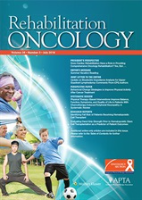
Rehabilitation Oncology
Scope & Guideline
Pioneering Discoveries in the Field of Cancer Rehabilitation
Introduction
Aims and Scopes
- Oncologic Rehabilitation Practices:
Focuses on rehabilitation strategies tailored for cancer patients, addressing physical, emotional, and psychological challenges post-treatment. - Patient-Reported Outcomes and Quality of Life:
Emphasizes the importance of patient-reported outcomes in assessing the effectiveness of rehabilitation interventions and their impact on quality of life. - Exercise and Physical Activity Interventions:
Investigates the role of exercise and physical activity in cancer recovery, exploring various modalities and their effects on fatigue, pain, and overall health. - Multidisciplinary Approaches in Cancer Care:
Promotes collaboration among healthcare professionals from various disciplines to enhance cancer rehabilitation and address complex patient needs. - Innovative Therapies and Technologies:
Explores the integration of novel therapies, including telehealth and virtual interventions, to improve access and engagement in rehabilitation.
Trending and Emerging
- Telehealth and Remote Rehabilitation:
There is a growing emphasis on telehealth models for delivering rehabilitation services, especially in light of the COVID-19 pandemic, which has accelerated the adoption of virtual care. - Mind-Body Interventions:
Research focusing on mind-body therapies, such as yoga and mindfulness, is on the rise, underscoring their importance in enhancing psychological well-being and coping strategies for cancer survivors. - Health Equity and Disparities:
A significant increase in attention to health equity issues, particularly concerning access to rehabilitation services for diverse populations, is evident in recent publications. - Personalized and Patient-Centered Care:
There is a trend towards personalized rehabilitation approaches that consider individual patient profiles, preferences, and unique needs, enhancing engagement and effectiveness. - Integration of Physical Activity in Survivorship Care Plans:
Emerging research focuses on embedding physical activity recommendations within survivorship care plans, highlighting its critical role in long-term health outcomes.
Declining or Waning
- Traditional Rehabilitation Models:
There is a noticeable decrease in studies focused solely on traditional in-person rehabilitation models, as newer, more flexible approaches such as telehealth gain traction. - General Cancer-Related Fatigue Studies:
While fatigue remains a concern, specific studies addressing general cancer-related fatigue without a targeted intervention have become less common, indicating a move towards more structured approaches. - Pediatric Oncology Rehabilitation:
Research specifically centered on pediatric oncology rehabilitation appears to have diminished, potentially reflecting a shift in focus towards adult populations or integrated care models. - Lymphedema Management as a Standalone Topic:
The exploration of lymphedema management as an isolated subject is declining, with a trend towards incorporating it into broader rehabilitation frameworks rather than treating it in isolation. - Pharmacological Interventions in Rehabilitation:
The focus on pharmacological approaches to manage rehabilitation outcomes is waning, as evidence increasingly supports non-pharmacological interventions such as exercise and lifestyle modifications.
Similar Journals
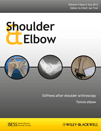
Shoulder & Elbow
Advancing Orthopedic Excellence.Shoulder & Elbow is a leading peer-reviewed journal published by SAGE Publications Inc, focusing on the critical domains of orthopedics, sports medicine, and rehabilitation. With an impressive impact in its field, the journal consistently ranks in the upper quartiles (Q1 and Q2) across multiple related categories, including Rehabilitation and Surgery. This underscores its significance as a platform for disseminating high-quality research and innovative practices aimed at enhancing patient outcomes in shoulder and elbow conditions. Since its inception in 2009, the journal has served as a vital resource for researchers, clinicians, and students alike, fostering collaboration and advancing knowledge in these specialized areas. Although it operates under a subscription model, the accessibility of its comprehensive articles aids professionals striving to stay informed about the latest advancements and methodologies in musculoskeletal health. Its Scopus rankings, including a commendable 62nd percentile in Medicine - Rehabilitation, further reflect its valuable contributions to the field. The journal is headquartered at 2455 Teller Rd, Thousand Oaks, CA 91320, United States, and aims to bridge the gap between research and practical application, solidifying its role in shaping future standards of care.
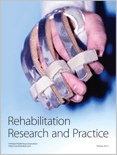
Rehabilitation Research and Practice
Empowering Recovery with Evidence-Based Practices.Rehabilitation Research and Practice is a distinguished open-access journal published by HINDAWI LTD, dedicated to advancing knowledge in the fields of rehabilitation, physical therapy, and sports therapy. With its ISSN 2090-2867 and E-ISSN 2090-2875, the journal has been a pivotal resource for researchers and practitioners since its inception in 2010. Based in Egypt and reaching an international audience, the journal encapsulates cutting-edge research and evidence-based practices that significantly contribute to patient care and rehabilitation strategies. Notably, it holds a reputable position in the Scopus rankings—42nd out of 161 in Medicine Rehabilitation and 74th out of 247 in Health Professions. The journal enjoys a Q2 status in the 2023 category quartiles, reflecting its influence and quality within the academic community. The journal's commitment to an open-access format not only enhances its visibility and accessibility but also fosters collaboration among professionals, making it an indispensable resource for anyone engaged in rehabilitation research and practice.

Journal of Pediatric Rehabilitation Medicine
Fostering Collaboration for Enhanced Pediatric Health OutcomesJournal of Pediatric Rehabilitation Medicine is a leading academic platform published by IOS PRESS, dedicated to advancing knowledge in the fields of pediatrics, rehabilitation, and physical therapy. With an ISSN of 1874-5393 and an E-ISSN of 1875-8894, this journal has carved a niche within the biomedical community, focusing on therapeutic innovations and evidence-based practices in pediatric rehabilitation. Recognized for its scholarly contributions, it holds a prestigious Q3 ranking in Pediatrics and Q2 rankings in both Physical Therapy and Rehabilitation categories, indicating its impact and relevance in the respective fields. Operating out of the Netherlands, the journal provides a comprehensive open access model that ensures that research is easily accessible to professionals, students, and researchers alike. With converged years spanning from 2007 to 2024, the journal continues to be an essential resource for those dedicated to enhancing the quality of life for children with disabilities and rehabilitation needs, fostering collaboration between clinicians and researchers through high-quality research dissemination.
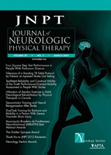
Journal of Neurologic Physical Therapy
Pioneering Knowledge in Neurologic RehabilitationJournal of Neurologic Physical Therapy, published by Lippincott Williams & Wilkins, stands as a premier resource in the field of physical therapy with a specific focus on neurology. With an ISSN of 1557-0576 and an E-ISSN of 1557-0584, this journal serves as a vital platform for researchers, practitioners, and students from 2004 to 2024, illustrating its commitment to advancing knowledge in neurologic rehabilitation. It holds a prestigious Q1 ranking in categories such as Physical Therapy, Sports Therapy, and Rehabilitation and Rehabilitation, alongside Q2 rankings in Geriatrics and Gerontology, Medicine (Miscellaneous), and Neurology (Clinical). With an impact factor that reflects its significance, the journal hosts comprehensive studies and clinical insights that propel practice and innovation in neurologic physical therapy. The content is designed to enhance understanding and skills, making it an indispensable resource for those dedicated to improving patient care and outcomes in this critical area of health.
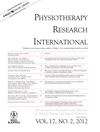
Physiotherapy Research International
Innovating Physiotherapy for Better Patient Outcomes.Physiotherapy Research International is a leading journal in the fields of Physical Therapy, Sports Therapy, and Rehabilitation, published by WILEY. With a commendable impact factor reflecting its significant contribution to the profession, this journal enjoys a competitive position, ranking in the 66th percentile and 84th out of 247 in its category according to Scopus. The journal encompasses a broad scope of research from 1996 to 2024, addressing critical advancements in physiotherapy and rehabilitation practices. Although it is not an Open Access journal, it provides valuable insights and research findings that foster knowledge and innovation among practitioners and researchers alike. As a Q2 category journal in its field for 2023, Physiotherapy Research International aims to facilitate the dissemination of high-quality research aimed at improving patient outcomes and guiding clinical practice. It serves as an essential resource for those committed to advancing the science and practice of physiotherapy.

Journal of Physiotherapy
Pioneering Knowledge for the Future of Physical TherapyThe Journal of Physiotherapy, published by the Australian Physiotherapy Association, is a leading peer-reviewed journal dedicated to advancing the field of physical therapy, sports therapy, and rehabilitation. With a stellar impact factor and ranked Q1 in the 2023 category of Physical Therapy, this journal serves as an essential resource for researchers, clinicians, and educators alike. Located in Australia, it features open access options that allow global dissemination of knowledge, enhancing the visibility of cutting-edge research from 2010 to 2024. With a commendable Scopus Rank of #5 out of 247 in its field, achieving the 98th percentile, the Journal of Physiotherapy is committed to enriching the evidence base within the profession and promoting best practices in physiotherapy. Whether you are searching for the latest clinical studies, innovative treatments, or comprehensive reviews, this journal provides a platform for high-quality scholarship that drives the profession forward.

ONCOLOGY REPORTS
Unveiling Breakthroughs in Oncology StudiesOncology Reports is a distinguished journal dedicated to advancing knowledge in the field of oncology. Published by Spandidos Publications Ltd, this journal has been a cornerstone in cancer research since its establishment in 1994 and is set to continue its impactful contributions until 2024. With ISSN 1021-335X and E-ISSN 1791-2431, it ranks in the Q2 category in Cancer Research, Medicine (Miscellaneous), and Oncology as of 2023, reflecting its solid standing in the academic community. The journal's current Scopus rankings position it notably within Medicine (Oncology) (#74/404, 81st percentile) and Biochemistry, Genetics and Molecular Biology (Cancer Research) (#67/230, 71st percentile), underscoring its rigorous peer-review process and the quality of its published research. Although not an open-access journal, Oncology Reports remains committed to disseminating vital information to researchers, professionals, and students, ensuring they stay at the forefront of developments in cancer studies. Its comprehensive scope promotes a multidisciplinary approach, encompassing clinical and experimental aspects of oncology, thus serving as an essential resource for those striving to understand and combat cancer.

INTERNATIONAL JOURNAL OF REHABILITATION RESEARCH
Elevating standards in rehabilitation research and clinical practice.INTERNATIONAL JOURNAL OF REHABILITATION RESEARCH, published by Lippincott Williams & Wilkins, stands as a vital resource within the fields of rehabilitation and physical therapy. With an ISSN of 0342-5282 and an E-ISSN of 1473-5660, this peer-reviewed journal has been disseminating groundbreaking research since its inception in 1978. As of 2023, it holds commendable rankings with a Q3 in Medicine (miscellaneous) and Q2 in both Physical Therapy, Sports Therapy, and Rehabilitation, as well as Rehabilitation, highlighting its significant contribution to these disciplines. The journal seeks to advance knowledge and practice in rehabilitation by serving as a platform for high-quality research, clinical studies, and theoretical discussions. It is particularly valuable for researchers, healthcare professionals, and students aiming to stay at the forefront of rehabilitation science and practice. Although not designated as open access, the journal remains accessible through various academic databases, ensuring that its content reaches a broad audience committed to improving rehabilitation therapies and outcomes.

Annals of Rehabilitation Medicine-ARM
Advancing Rehabilitation Science for a Healthier TomorrowAnnals of Rehabilitation Medicine (ARM), published by the Korean Academy of Rehabilitation Medicine, is a distinguished open-access journal dedicated to advancing the field of rehabilitation medicine since its inception in 1977. With its E-ISSN 2234-0653, ARM aims to disseminate high-quality, peer-reviewed research that reflects both the breadth and depth of rehabilitation practices. As of 2023, the journal ranks in the Q2 quartile within the Rehabilitation category, placing it among the top half of journals in this domain, and it holds a respectable position in the Scopus rankings, being 70th out of 161 in the discipline. This journal emphasizes the importance of innovative research and clinical practices that improve patient outcomes in rehabilitation settings. Researchers, clinicians, and students alike will find valuable insights and the latest developments in rehabilitation science, enhancing their understanding and practice through its accessible content.
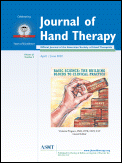
Journal of Hand Therapy
Innovating rehabilitation strategies for optimal patient outcomes.Welcome to the Journal of Hand Therapy, a premier publication dedicated to advancing the field of hand therapy through rigorous research and clinical insights. Published by Hanley & Belfus-Elsevier Inc, this esteemed journal, with ISSN 0894-1130 and E-ISSN 1545-004X, has been a cornerstone for professionals since its inception in 1987. With a commendable impact factor and categorized in the Q2 and Q1 quartiles for Physical Therapy, Sports Therapy, Rehabilitation, and Medicine, it ranks among the top journals in its fields, listed at #46/161 and #78/247 respectively in Scopus rankings. The journal aims to disseminate innovative research, evidence-based practices, and comprehensive reviews, addressing contemporary challenges in hand therapy, making it an essential resource for researchers, practitioners, and students alike. With a commitment to enhancing patient care, Journal of Hand Therapy is your gateway to the latest developments and trends in this critical area of rehabilitation.